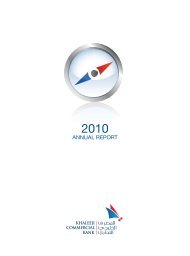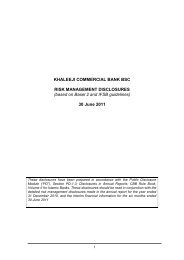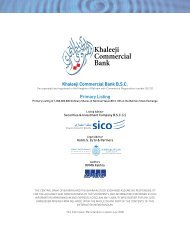2011 Annual Report - Khaleeji Commercial Bank BSC
2011 Annual Report - Khaleeji Commercial Bank BSC
2011 Annual Report - Khaleeji Commercial Bank BSC
Create successful ePaper yourself
Turn your PDF publications into a flip-book with our unique Google optimized e-Paper software.
KHALEEJI COMMERCIAL BANK <strong>BSC</strong><br />
RISK MANAGEMENT DISCLOSURES<br />
7. Other Risks (continued)<br />
7.3 Counterparty credit risk<br />
Counterparty credit risk is the risk that a counterparty to a contract in the profit rate, foreign exchange, equity and credit<br />
markets defaults prior to maturity of the contract. The <strong>Bank</strong> does not engage in proprietary trading of equity, foreign exchange<br />
or its derivatives. However, the <strong>Bank</strong> enters into Shari’a compliant foreign exchange risk/ profit rate risk transactions to hedge<br />
its risks arising out of mismatch in its asset liability portfolios. Clear policies for such transactions are in place. For other credit<br />
markets transactions (primarily interbank placements), the <strong>Bank</strong> has established a matrix of counterparty limits based on<br />
external credit rating of such counterparties. Such limits are constantly monitored by the <strong>Bank</strong>s Risk Management Department.<br />
As at 31 December <strong>2011</strong>, the <strong>Bank</strong> did not have any open position in foreign currency risk management instruments.<br />
7.4 Concentration risk<br />
Concentration risks arises when a number of obligors, counterparties or investees are engaged in similar business activities or<br />
activities in the same geographic region or have similar economic features that would cause their ability to meet contractual<br />
obligations to be similarly affected by changes in economic, political or other conditions. Accordingly, such concentrations<br />
indicate the relative sensitivity of the <strong>Bank</strong>’s performance to developments affecting a particular industry or region. The <strong>Bank</strong><br />
has established exposure limits to various geographic regions and industry sectors. For break-up of exposure geography and<br />
industry / sector wise, please refer to notes 4.3.1 and 4.3.2 above.<br />
7.5 Reputational risk<br />
Reputation risk is the risk that negative perception regarding the <strong>Bank</strong>’s business practices or internal controls, whether true<br />
or not, will cause a decline in the <strong>Bank</strong>’s investor base, lead to costly litigation that could have an adverse impact on liquidity or<br />
capital of the <strong>Bank</strong>. Being an Islamic <strong>Bank</strong>, reputation is an important asset and among the issues that could affect the <strong>Bank</strong>’s<br />
reputation is the inability to exit from investments, lower than expected returns on investments and poor communication to<br />
investors. The <strong>Bank</strong> has a well-developed and coherently implemented communication strategy to cover such contingencies.<br />
The <strong>Bank</strong> also allocates additional capital for such risks under its ICAAP.<br />
7.6 Displaced commercial risk<br />
Displaced <strong>Commercial</strong> Risk refers to the market pressure to pay returns that exceeds the rate that has been earned on the<br />
assets financed by equity of investment account holders. This can be due to the return on such assets being lower than that<br />
of competitors. The <strong>Bank</strong> has adequate policies and procedures in place to identify, monitor and address all potential risks that<br />
may arise from such activities. Please refer to the section on IAH for further details.<br />
7.7 Other risks<br />
Other risks include strategic risk, fiduciary risks, and regulatory risks etc. which are inherent in all business and are not easily<br />
measurable or quantifiable. The <strong>Bank</strong>’s Board has overall responsibility for approving and reviewing the risk strategies and<br />
amendments to the risk policies. The <strong>Bank</strong> senior management is responsible for implementing the risk strategy approved<br />
by the Board. The management also ensures that internal systems of corporate governance and regulatory compliance for<br />
management of fiduciary and reputational risks are robust and effective. The <strong>Bank</strong> also allocates additional capital for such<br />
risks under its ICAAP.<br />
8. Product Disclosures<br />
8.1 Product descriptions & consumer awareness<br />
The <strong>Bank</strong> offers a comprehensive mix of Shari’a compliant commercial and investment banking products. This include, apart<br />
from traditional financing products, a range of innovative structured investment products like funds, repackaged investments<br />
and restricted Murabaha’s. The investment department of the <strong>Bank</strong> has expertise in creating innovative high end and value<br />
added products offering a wide range of structures, expected returns, tenors and risk profiles.<br />
Proposal for any new product is initiated by individual business lines within the <strong>Bank</strong>. The Executive Risk Management<br />
Committee (“ERMC”) of the <strong>Bank</strong> reviews such proposal to ensure that the new product/ business are in line with the <strong>Bank</strong>’s<br />
business and risk strategy. All new products will need the approval of the Board of Directors and the Shari’a Supervisory<br />
Board of the <strong>Bank</strong>.<br />
98<br />
<strong>Annual</strong> <strong>Report</strong> <strong>2011</strong>










